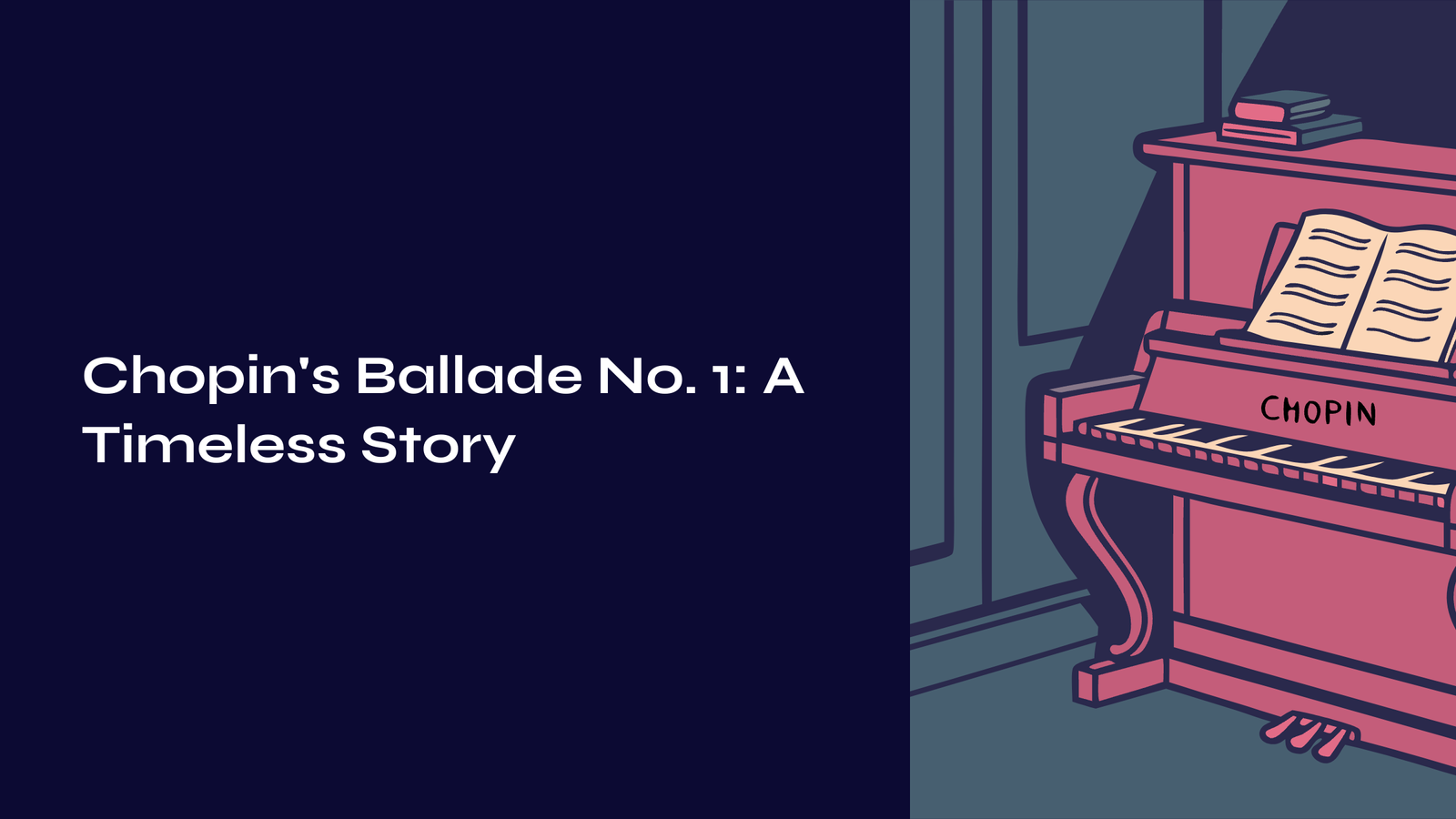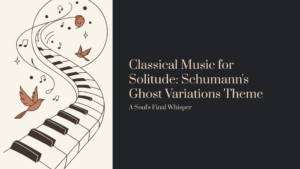Table of Contents
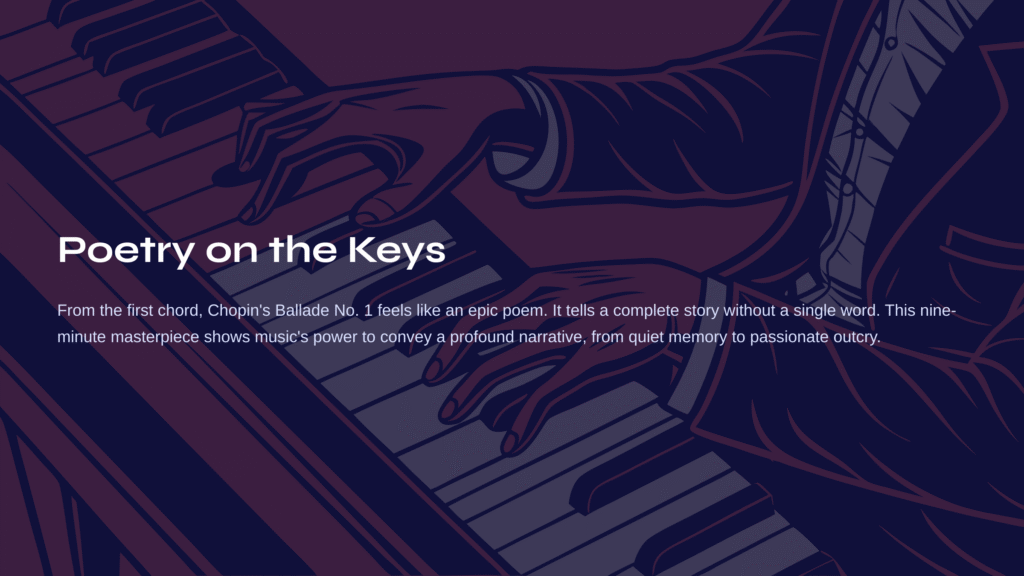
An Afternoon When Poetry Bloomed on the Keys
There are moments when you sit before a piano and sense that something profound is about to unfold, even before your fingers touch the keys. That’s exactly how I felt when I first encountered Chopin’s Ballade No. 1 in G minor. As the opening chord resonated through the air, I knew instantly that this wasn’t merely a piece for performance—it was an epic poem containing someone’s entire life story.
Within the span of roughly nine minutes, this masterwork takes us into the deepest recesses of a human soul. The journey begins with quiet reminiscence and culminates in passionate outcry, unfolding like a novel with its protagonist, conflicts, climax, and resolution. Most remarkably, this entire narrative is conveyed through pure sound, without a single word, demonstrating the transcendent power of music as a universal language.
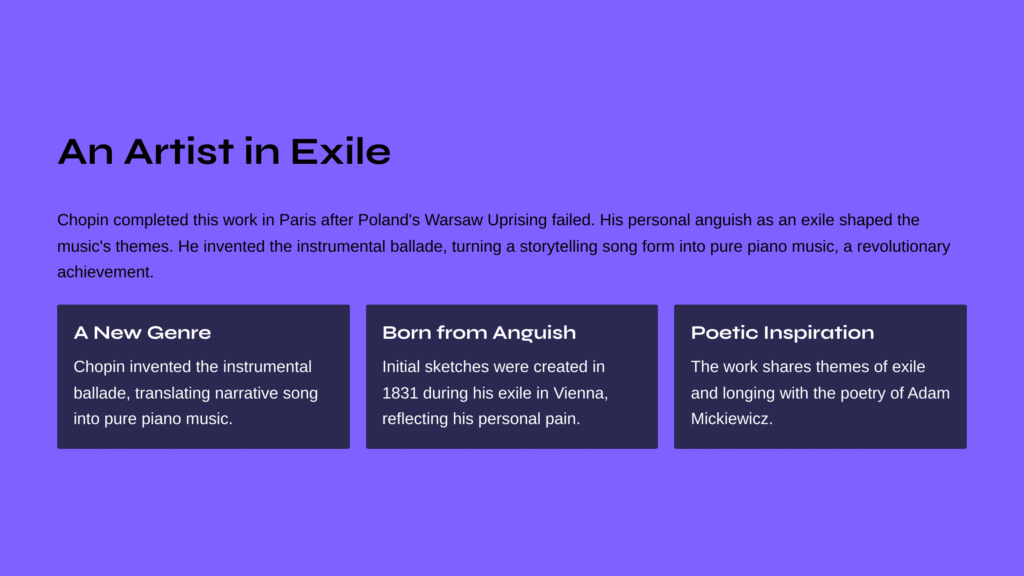
The Heart of a Young Artist in Exile
In 1835, twenty-five-year-old Chopin completed this work while settling into his new life in Paris. Four years earlier, in 1831, the Warsaw Uprising had ended in failure, leaving Poland once again under foreign rule. Chopin found himself in Vienna, receiving news of his homeland’s fate from afar. During those eight months of exile, the initial sketches of this ballade were born from profound personal anguish.
Robert Schumann suggested that Chopin’s ballades drew inspiration from the works of Polish Romantic poet Adam Mickiewicz. Both artists had fled political upheaval in their homeland and found refuge in Paris, sharing themes of exile, nostalgia, and patriotic longing. While we cannot definitively trace specific literary sources for this work, the music itself unmistakably unfolds as a wordless epic poem.
The ballade as an instrumental genre was essentially Chopin’s invention. Originally, ballades were narrative folk songs that told stories through verse and melody. Chopin revolutionized this concept, translating the storytelling tradition into pure piano music. Though Liszt and Brahms would later compose their own ballades, Chopin’s pioneering achievement remains unmatched in its innovation and artistic completion.
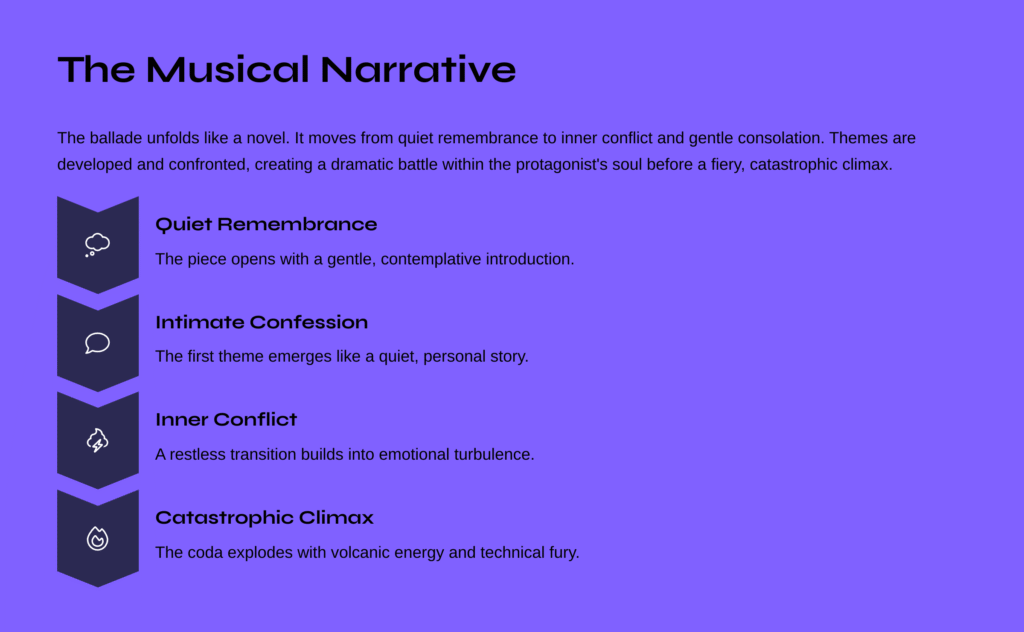
The Unfolding Musical Narrative
A Prelude of Quiet Remembrance
The work opens with a gentle arpeggiation in A-flat major, like someone lost in deep contemplation, slowly gathering fragments of memory. Though this introduction spans only seven measures, it contains the seeds of every musical idea that will later flourish. The appoggiatura resolution—that poignant moment of tension and release—becomes the work’s central motif, threading through the entire composition like a literary leitmotif that defines the protagonist’s character.
First Theme – An Intimate Confession
The first theme emerges in G minor, marked cantabile in 6/4 meter. True to its “singing” indication, this melody feels like someone quietly sharing their deepest thoughts. The ascending arpeggiation followed by stepwise descent captures the complex interplay of hope and resignation, joy tinged with melancholy.
Whenever I hear this passage, I envision a solitary figure sitting in darkness, rain pattering against the window, quietly murmuring reflections on times past. The voice carries both happiness and sorrow, transmitted through the piano’s expressive capabilities in a way that words alone could never achieve.
Transition – The Stirring of Inner Conflict
As the first theme concludes, the music grows increasingly restless. The left-hand accompaniment suggests a waltz rhythm while harboring an underlying anxiety. This transitional passage seems to capture the moment when peaceful reminiscence begins transforming into emotional turbulence—the calm before an internal storm.
Second Theme – Gentle Consolation
With a shift to E-flat major, the second theme presents an entirely different character. Marked sotto voce (“in a small voice”), this melody feels like a tender hand reaching out to comfort a wounded heart. Its antecedent-consequent structure creates the impression of two voices in intimate conversation.
This section never fails to warm my heart. It’s as if someone approaches our lonely protagonist and offers a helping hand. Yet those familiar with musical structure already sense that this tranquility cannot last forever.
Development – Confronting Destiny
The middle development section transforms the familiar themes around A minor and A major, introducing a third theme that directly conflicts with the previous material. Rather than smoothly connecting themes as in traditional sonata form, Chopin creates dramatic confrontations through sudden, jarring contrasts. This feels like a musical representation of the fierce battle raging within the protagonist’s soul.
Recapitulation – The Significance of Reversed Order
Unlike conventional sonata form, this work’s recapitulation presents themes in reverse order. The second theme returns first, now in G minor, followed by the first theme. This structural innovation isn’t mere technical experimentation—it serves the musical narrative’s inherent logic.
It’s as if the protagonist, looking back on their story, views the same events from a completely different perspective. The same melodies now carry entirely new meanings. This is Chopin’s genius: formal innovation perfectly aligned with emotional truth.
Coda – Catastrophic Climax
The final coda, marked Presto con fuoco (“very fast, with fire”), represents the work’s most shocking transformation. The previously lyrical and introspective atmosphere explodes into volcanic energy. Rapid scales and complex rhythmic patterns cascade like an emotional dam bursting.
This section demands what critics call “demonic difficulty” from the performer. Yet this challenge isn’t mere technical showmanship—such extreme expression is necessary to convey the protagonist’s inner tumult erupting into the external world.
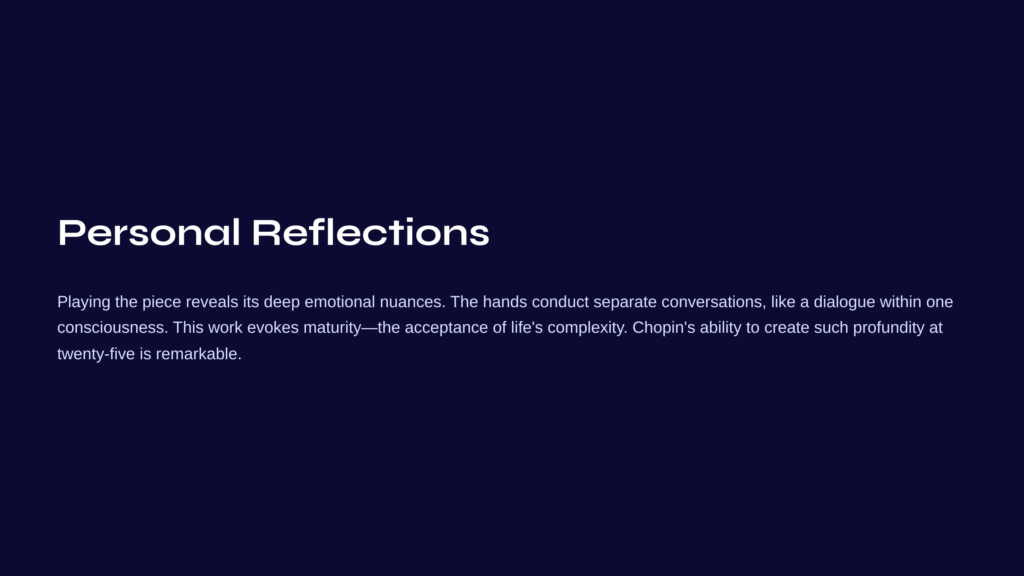
Personal Reflections – What Music Taught Me
I truly understood this work only after attempting to play it myself. Though I still cannot perform it perfectly, following those melodies with my own fingers revealed subtle emotional nuances that pure listening had missed.
Particularly striking was how the left and right hands seem to conduct separate conversations—sometimes comforting each other, sometimes conflicting, sometimes uniting toward a common goal. This felt like witnessing a dialogue between multiple selves within a single consciousness.
The work also creates a unique relationship with time. Nine minutes of performance can feel instantaneous or eternal. Especially in the coda, time seems compressed as if all of life’s moments converge into a single point.
Personally, this work always evokes the concept of “maturity”—not simple joy or sorrow, but the mature perspective that accepts life’s complexity while finding beauty within it. That Chopin could create such profundity at twenty-five seems miraculous, yet considering his personal and historical trials, it becomes comprehensible.
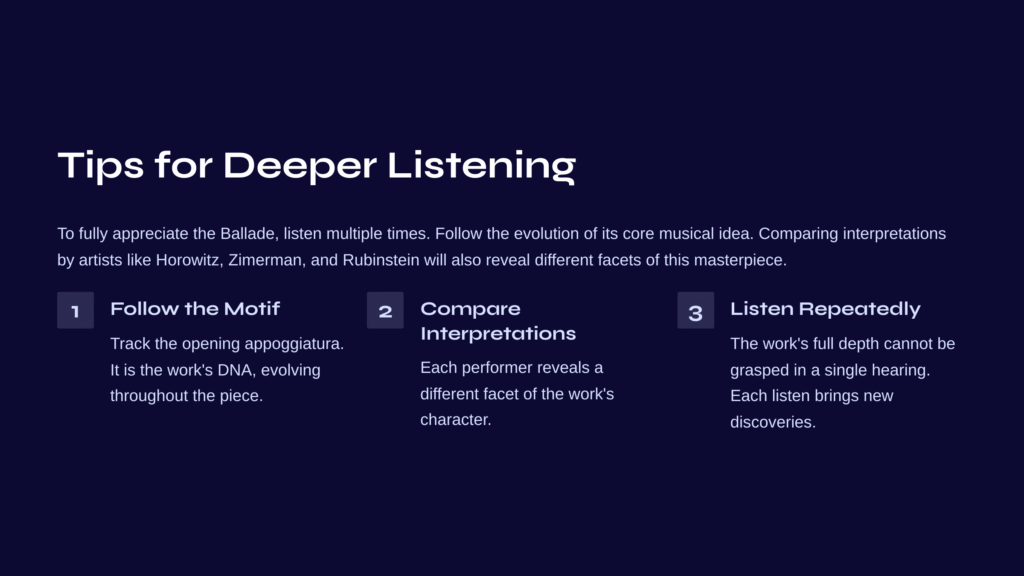
Listening Tips for Deeper Understanding
First, follow the motivic transformations. The 7-6 appoggiatura resolution from the introduction is the work’s DNA, threading throughout the entire composition. Tracking how this small gesture evolves and develops reveals the music’s internal logic, much like following a recurring symbol through a great novel.
Second, compare different interpretations. Horowitz’s 1960s recordings exemplify dramatic interpretation, while Zimerman achieves remarkable balance between technical precision and musical sensitivity. Pollini emphasizes structural clarity, Rubinstein romantic lyricism. Each interpretation reveals different facets of the work’s multifaceted character.
Third, embrace repeated listening. This work absolutely cannot reveal its full depth in a single hearing. Listen first for overall flow, then for thematic characteristics, then for harmonic progressions. Each encounter brings new discoveries, like rereading a masterpiece of literature.
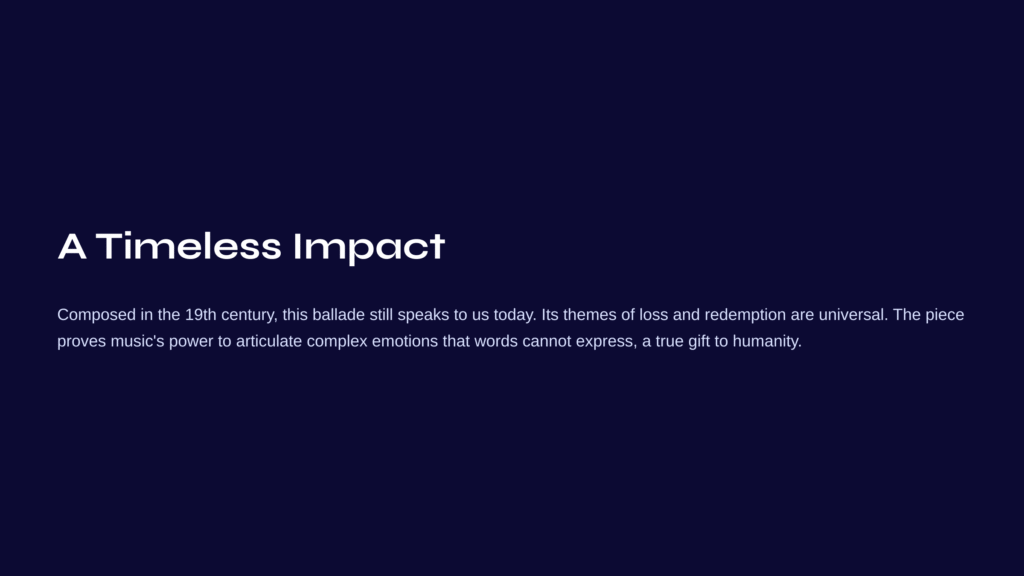
Transcendent Impact
Though composed in the 19th century, Chopin’s Ballade No. 1 still speaks powerfully to 21st-century listeners. The young exile’s pain, the journey through personal loss toward redemption, salvation through art—these themes possess timeless universality.
Most importantly, this work demonstrates music’s narrative power. Complex emotions and experiences that no words could adequately express find perfect articulation through pure sound. This might be music’s greatest gift to humanity.
Tonight, if you find yourself alone, I encourage you to listen to this work. Dim the lights, close your eyes, and open your heart completely. Chopin’s profound emotions from 190 years ago will cross time to reach you, and you’ll experience firsthand that music truly is a language beyond temporal boundaries.
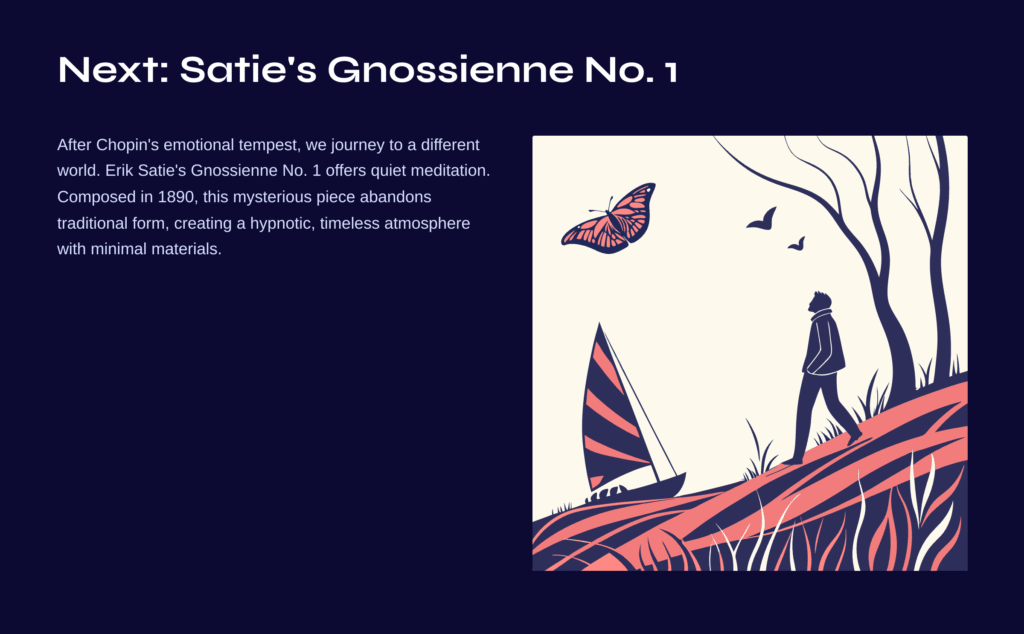
Next Destination – Satie’s Gnossienne No. 1
After experiencing Chopin’s passionate epic, it’s time to journey into a completely different world. Erik Satie’s Gnossienne No. 1 offers attractions diametrically opposite to Chopin’s Ballade. If Chopin’s work is an emotional tempest, Satie’s is a time of quiet meditation.
Composed in 1890, this mysterious work abandons time signatures, blurs bar lines, and completely ignores traditional formal conventions. Yet the depth discovered within this simplicity strikes more powerfully than any complex composition. The hypnotic atmosphere created by repetitive melodies and parallel fifths makes us feel suspended in timeless space.
Especially for ears accustomed to Chopin’s romantic passion, Satie’s restrained beauty feels refreshingly novel. Satie’s musical philosophy of creating maximum impact with minimal materials reminds us living in our complex modern world of “the power of simplicity.” While Chopin explored humanity’s complex interior landscape, Satie reveals the quiet essence that lies beyond.
